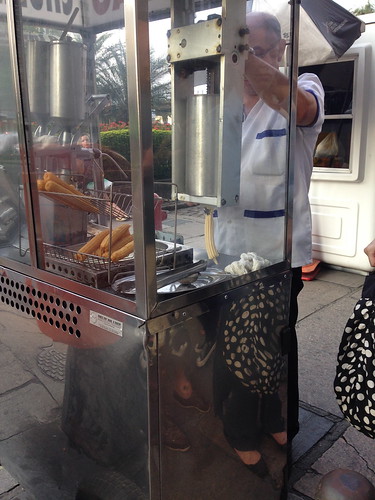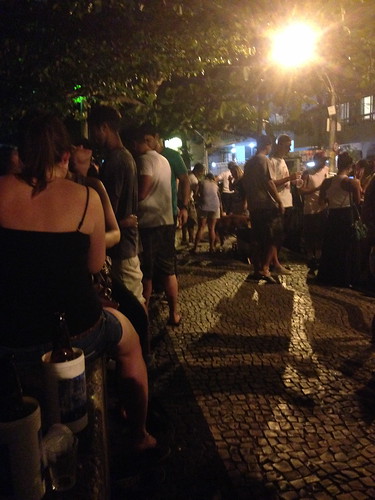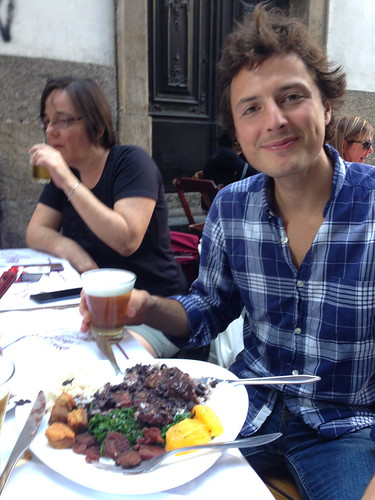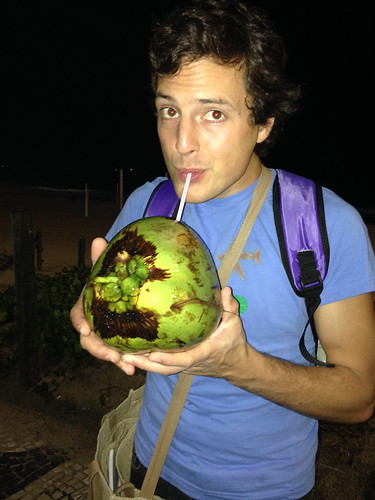They eat better in Sao Paulo, but my preference is for the street food of Rio de Janeiro. Which is both cheaper and more unique than the Western-style pizzas and pastas and meat-heavy dishes at most Carioca restaurants. (By meat-heavy, I mean that a common dish is simply a huge platter of grilled or fried beef, with a side of french fries or potatoes.)
Street food is what I mainly subsist on here, alongside my homemade cooking of rice and carrots. (I’ve had to forgo my black bean diet, as beans of any sort are oddly expensive at about $3 per can, compared to $0.79 back in NYC.) So of course, street food is what I fed Sarah when she visited the last half of October, washed down by many caipirinhas and cans of Antarctica beer.
CHURROS: All over the city, all day long, churro vendors stand behind metallic carts frying these tubular donuts. You know the smell upon entering a Krispy Kreme donut shop? That’s the heavenly smell always wafting from these churro vendors. Below, a vendor is pumping a glob of dough out of a canister, which then goes into the grease vat. A fresh, hot churro is then filled with chocolate creme or doce de leite at your request.


SALGADOS: I love salgados, which here refers to any sort of dough filled with salty goodness. This comes in many forms. Pastels are fried pierogi-looking half-circles filled with either cheese or meat. Empanadas look similar, but they’re actually baked (elsewhere in Latin America an empanada is what people here call pastels.) Pastels, at least in Rio-lingo, are thin rectangular fried dough sandwiches filled with cheeses or meats or pizza-filling. My favorite salgado is the empada, which looks like a pie, and often best when filled with shrimp (“camarão”) or palm heart (“palmito”).
The best empadas and pastes are at Bar Urca, an unassuming corner restaurant in the neighborhood of Urca in the shadow of the iconic peak of Pao de Acucar. Below left is the scene outside Bar Urca on a Monday night, with probably more than 100 locals eating empadas and drinking tall bottles of the country’s beloved Antarctica cerveja. Below right is a pastel from the restaurant Antigamente.


FEIJOADA: My favorite Brazilian meal is feijoada, considered the national dish of Brazil. But more than a dish, feijoada is an experience. Feijoada is often enjoyed on Saturday afternoons, and many restaurants don’t even serve it the other six days of the week. It’s Rio’s version of brunch in New York City. And like boozy brunches in NYC, feijoada is usually enjoyed alongside many glasses of chopp (draft beer) — the perfect antidote to a late Friday night.
Feijoada, pictured below right, specifically refers to a clay pot stew of beans cooked with beef and pork. It is served alongside collared greens, rice, and farofa (cassava ground down to a powder and toasted). The protein-rich meal is particularly good after running up Corcovado Mountain and then getting lost in Floresta de Tijuca, the world’s largest urban forest…


PAMONHA: Other common street food is corn-on-the-cob, tapioca omelets (salty or sweet), and pamonha, which is what Sarah is eating below. Variants of pamonha are found worldwide, but in Brazil it is a boiled corn paste wrapped in corn husk and served savory (filled with meet) or sweet (filled with coconut milk). Like everything in Brazil, it is best when washed down by Antarctica beer.


COCO: It’s wonderful living in a country where coconuts literally fall from the sky bearing sweet water and juicy flesh. Street vendors around Rio sell chilled coconuts for BRL 4 – 5 reals (about $2). This was undoubtedly the healthiest thing we consumed.
